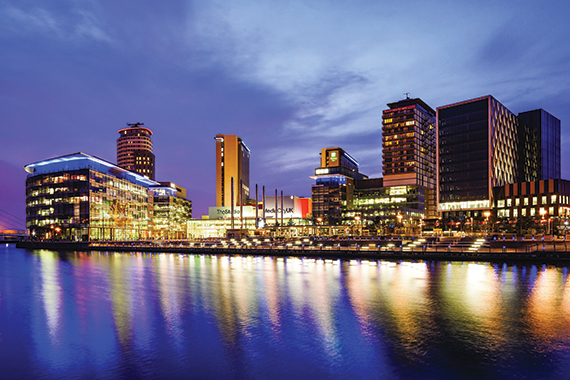 Manchester’s investment market clocked up an incredible £1.4bn of transactions in 2015, according to Bilfinger GVA – more than any other regional city in the UK, and nearly one-third of that was overseas money.
Manchester’s investment market clocked up an incredible £1.4bn of transactions in 2015, according to Bilfinger GVA – more than any other regional city in the UK, and nearly one-third of that was overseas money.
Yet, after 24 months of rising prices and yield compression, there are signs that the tide may be turning. The second half of 2015 was significantly quieter than the first half – Leeds transacted more than Manchester during that period – and agents suggest that if the market has not hit a wall, then it is at least pausing for breath.
“Post-summer, some steam went out of the market,” says CBRE’s Colin Thomasson. “UK institutions became less acquisitive. There was a feeling that they had done a lot of their buying earlier in the year and pricing meant that some assets were not as attractive as they once were.”
Macroeconomic issues are invariably affecting investor appetite, be it global stock market volatility or the impending EU referendum.
Manchester’s office yields are now 5% and under on some prime assets, but the predominant view is that further compression is unlikely. This may weaken the incentive to buy for some investors, and with so much of the city centre’s prime office stock already traded over the past couple of years, the pipeline for major investment transactions is drying up.
Lambert Smith Hampton’s Abid Jaffrey says: “If buildings are available, the investors are too, but this year will be all about finding the right stock.”
Thomasson adds: “With owners bringing less product onto the market, it is difficult to see how we can hit the same kind of transaction volumes in 2016 as we did last year.”
Outside the super prime assets, investors seem undeterred and they may just look for deals further up the risk curve that offer re turns beyond yield compression.
Cushman & Wakefield’s Craig Barton says: “If less stock is traded this year, it is definitely not down to a lack of demand. Manchester has a very strong occupational market and the limited supply will lead to rental growth. So it wouldn’t take much of a shift in macro issues to get these investors motivated again.”
Manchester’s international brand and strong fundamentals have attracted a wide variety of investors in recent times, from UK institutions to Asian sovereign wealth, US private equity to Far East mega funds.
Key overseas deals in 2015 included the £32m sale of 101 Barbirolli Square to European investor AEW at a 6.4% yield, Deutsche Asset & Wealth’s £100m forward-funding of 2 St Peter’s Square, and Credit Suisse’s acquisition of three separate city centre office buildings totalling more than £30m.
Also last year, Singapore-based Rowsley and Beijing Construction and Engineering Group agreed to back the £100m mixed-use redevelopment of the former Manchester Stock Exchange; now called St Michael’s, Singaporean REIT Mapletree purchased 3 Hardman Street for £205m as part of a regional portfolio; and Chinese conglomerate Xinjiang HuaLing Industry & Trade Group agreed to invest in Scarborough Developments’ £730m Salford project, Middlewood Locks.
Despite sharpening yields, Manchester still offers value compared with London and compares favourably with alternative investments, such as gilts.
Gavin Winbanks, who heads UKTI’s Regeneration Investment Organisation (ROI), which presents UK property investment opportunities to investors across seven global markets, says: “There is no shortage of international investors keen to get into Manchester. It is top of the list of regional cities that they want to talk about. They are drawn to the quality of product on offer and strong civic leadership committed to getting things done.”
Although a shortage of prime investment may be looming, there is enough product on the market to secure a decent start to 2016. The imminent sales of two assets alone – 3 & 4 Piccadilly Place and 1 St Peter’s Square – could boost the city’s transaction tally by about £300m.
Meanwhile, Moorfield Group and Oaktree Capital are selling 100 Barbirolli Square and L&G is rumoured to be poised to buy 1 New York Street.
JLL is handling the sale of Ask’s 170,000 sq ft Number One First Street. The vendor’s pricing aspirations have changed since they began talking with investors late last year and JLL is reporting good interest in the building, hoping to achieve a yield of 5.75%.
GVA’s Mark Rawstron is confident that Manchester can still attract significant investment activity. “Vendors’ expectations are now back to sensible levels as demand is now driven by the occupational market rather than investment hype,” he says.
Rental growth in secondary office stock may also prove appealing as prime stock dries up.
JLL’s James Porteous says: “As the city centre has expanded, it has presented opportunities for buildings that previously would not have been considered to be in the core. With supply and demand dynamics, you can see £23 per sq ft rents moving to £28 per sq ft quite easily.”
Knight Frank’s Steve Carrick adds:
“I can’t see many Spinningfields-level buildings being traded. A greater
range of investors will be drawn to A-minus or B-plus buildings which are 10 to 15 years old, where they can move rents on.”
So although diminishing stock will be an issue, agents remain confident that the weight of money looking to buy will keep Manchester’s market buoyed.
Long-term players
UK institutions may find it harder to secure the right stock with the right returns, but their appetite for Manchester is as keen as ever.
M&G boasts an impressive Greater Manchester portfolio, incorporating more than £500m of assets. In June 2014, it spent around £320m purchasing 1 Spinningfields Square and 1 Hardman Boulevard, both leased to RBS. That was followed in January 2015 with the £92m acquisition of Spinningfields’ 3 Hardman Square from Credit Suisse Asset Management.
The investor controls a large chunk of Manchester’s retail market through its ownership of the Arndale shopping centre and has also been keen to boost its presence in the North West industrial market. Last year it agreed to fund the construction of 400,000 sq ft of distribution space at Bolton’s Logistics North and a 175,000 sq ft warehouse at Union Square, Trafford Park.
“We are long-term-income-driven investors prepared to live through different economic cycles and when you look at the fundamentals, Manchester is set fair,” says M&G’s Chris Perkins.
Perkins believes Manchester city centre office yields will now stabilise and offer a discount of 150 basis points on those in central London. He is confident that, given the level of occupier demand and limited grade-A availability, mid-£30 per sq ft rents will become firmly established in the city centre.
“We are seeing the benefits of improved connectivity, a skilled workforce,” says Perkins. “The leadership offered by the council is also very encouraging, as is its willingness to work with surrounding cities.
“We do have to be more selective now as some assets are fully priced, but we are also keen to get involved in development ourselves, to increase our risk and returns and avoid having to battle for product with our competitors.”
Fellow UK investor L&G also remains upbeat about Manchester’s credentials, despite the recent hike in pricing.
In 2015, L&G invested a total of £324m in new Greater Manchester product. Highlights include the Salford office scheme One New Bailey and the purchase of a 50% stake in Peel’s £500m MediaCity.
“Other regional cities may offer a discount in terms of yields, but the difference is not huge,” says L&G Real Assets’ Bill Page. “Manchester’s fundamentals justify the difference.”
Page and his team have carried out research around growth hubs, creating a model to predict growth in different parts of the UK and inform fund managers about where best to invest.
“Manchester city centre appears in the first quintile and Salford in the second, which is why we are still very upbeat about the area,” he says.
Devolution, HS2 and the Ordsall Chord rail project are cited as positive factors. Page adds: “Strong occupational demand and limited grade-A stock will drive rents and support a sustainable investment market.”











